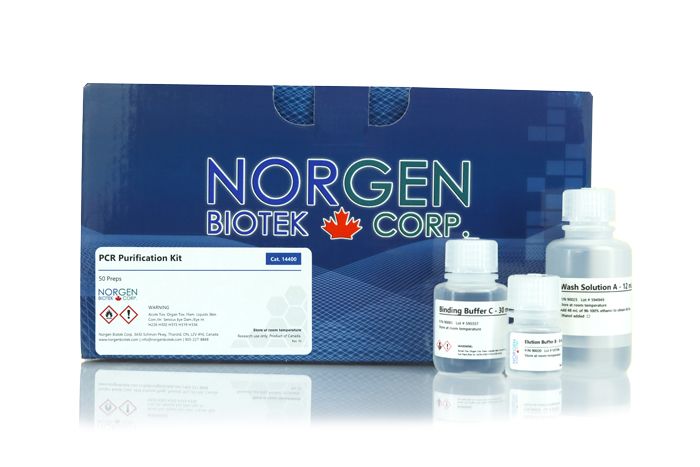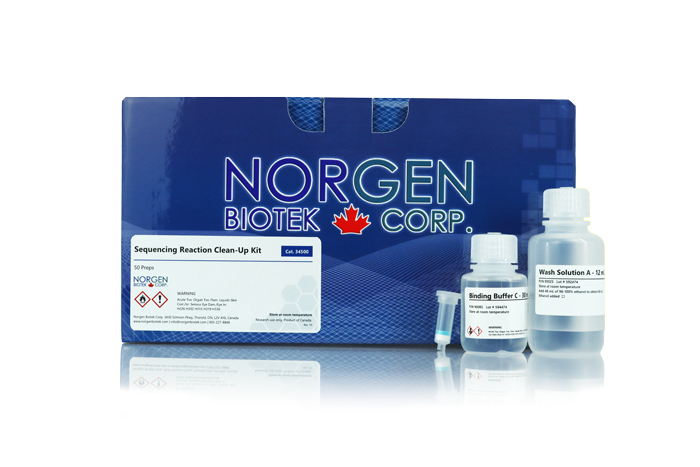PCR Purification Kit
For the rapid purification of amplified DNA products from PCR mixes

For the rapid purification of amplified DNA products from PCR mixes
PCR Purification Kit
For the rapid purification of amplified DNA products from PCR mixes
Features and Benefits
- Purify amplified DNA ranging from 100 bp -15,000 bp in size
- Fast and efficient spin column format
- Available in a 50 prep size and a 250 prep size
- Also available in 96 well format
This kit enables the rapid purification of amplified DNA products from PCR mixes. It is able to effectively remove PCR by-products including primers, dimers, enzymes, unincorporated nucleotides and mineral oil from the desired PCR product. The purified PCR products are fully compatible with restriction enzyme digestion, ligation into vectors, labeling, sequencing and more. This kit can also be used as an alternative to organic extraction and ethanol precipitation to clean up various enzymatic reactions.
The kit is also available in a 96-well format for high-throughput PCR purification. Purification with the 96-well plate can be performed using either a vacuum manifold or centrifugation.
Details
Supporting Data
Figure 1. High Yield Purification. The high yield of Norgen's PCR Purification Kit is illustrated by purifying 3.5 µg of a 500 bp PCR-amplified product from a reaction mixture and comparing the recovery with a competitor. The purifications were performed in triplicate. DNA recovery was quantified by running 350 ng (1/10th) of the input and 5 µL (1/10th) of 50 µL DNA elution on a 1X TAE, 1% agarose gel followed by densitometry. The average yield for each kit is shown in Figure 1. Norgen's kit shows a significantly higher recovery than the competitor's kit.
Figure 2. Removal of Primer-Dimers. Primer-dimers present in PCR reactions are effectively removed during the purification process with Norgen's PCR Purification Kit. One microgram of a 700 bp PCR fragment, spiked with 250 pmole of primer (Lane 1) was purified using Norgen's kit, with high recovery and no traces of spiked primer present in the elutions (Lanes 2 and 3). Lane 1 contains 400 ng (40%) of the input, and Lanes 2 and 3 contain 20 µL (40%) of the 50 µL elution (duplicate). Lane M is Norgen's MidRanger 1kb DNA Ladder. Eluted DNA was resolved on a 1X TAE, 1% agarose gel.
|
Kit Specifications - Spin Column
|
|
| Column Binding Capacity |
10 μg
|
| Size of DNA Purified |
100 - 15,000 bp
|
| Average Recovery |
> 90%
|
| Average Primer Removal |
> 90%
|
| Minimum Elution Volume |
30 μL
|
| Time to Complete 10 Purifications |
15 minutes
|
Storage Conditions and Product Stability
All solutions should be kept tightly sealed and stored at room temperature. This kit is stable for 1 year after the date of shipment.
| Component | Cat. 14400 (50 preps) | Cat. 45700 (250 preps) | Cat. 24800 (192 preps) |
|---|---|---|---|
| Binding Buffer C | 30 mL | 5 x 30 mL | 3 x 30 mL |
| Wash Solution A | 12 mL | 2 x 20 mL | 2 x 38 mL |
| Elution Buffer B | 8 mL | 2 x 30 mL | 2 x 15 mL |
| Spin Columns | 50 | 250 | - |
| Collection Tubes | 50 | 250 | - |
| 96-Well Plate | - | - | 2 |
| Adhesive Tape | - | - | 4 |
| 96-Well Collection Plate | - | - | 2 |
| Elution Tubes (1.7 mL) | 50 | 250 | - |
| 96-Well Elution Plate | - | - | 2 |
| Product Insert | 1 | 1 | 2 |
Documentation
FAQs
Spin Column, High Throughput
Poor DNA recovery could be due to one or a combination of the following factors:
- Binding of DNA to the column/wells was inefficient.
Binding of the DNA is dependent on both pH and salt concentration. Ensure that an appropriate amount of Binding Buffer C was used for the volume of the PCR reaction.
- The appropriate amount of ethanol was not added to the Wash Concentrate.
The Wash Solution A has been specifically designed to contain the appropriate amount of components. Ensure that the Wash Solution A was prepared using the correct amount of ethanol.
- Binding Buffer C was not completely removed in the wash step.
Traces of salt left on the column/wells from the binding step may interfere with the elution of the DNA. Ensure that the columns/wells are washed with the Wash Solution A.
- Proper Elution Buffer was not used.
The provided Elution Buffer B has been optimized for high elution recoveries. If water or TE buffer is used instead, ensure the pH is around 8.
- Elution Buffer B was not placed directly onto the column bed.
It is important that the Elution Buffer B be placed directly onto the column bed, as this helps to increase recovery by ensuring an even passing of the buffer through the column. Do not pipette the Elution Buffer B onto the side of the column.
Purified DNA may not be performing well in downstream applications due to:
- Insufficient washing of plate with bound DNA.
Traces of salt from the binding step may remain in the sample if the columns/wells are not properly washed with the Wash Solution A. Ensure that the columns/wells are washed with the Wash Solution A for 2 minutes during the washing step. Salt may interfere with downstream applications, and thus must be washed from the column.
- Eluted DNA contains residual ethanol.
Ensure that the drying step is performed after the second DNA wash to remove all traces of ethanol.
Well clogging could be due to the following reasons:
- Insufficient Vacuum.
Ensure that a vacuum pressure of at least -650 mbar or -25 in. Hg is developed.
- Centrifuge temperature is too low.
Ensure that the centrifuge remains at room temperature throughout the procedure. Temperatures below 15°C may cause precipitates to form that can cause the wells to clog.
Citations
| Title | First Generation Automated DNA Sequencing Technology |
| Citation | Current Protocols in Molecular Biology 2023. |
| Authors | Barton E. Slatko, et.al. |
| Title | AtROS1 overexpression provides evidence for epigenetic regulation of genes encoding enzymes of falvonoid biosynthesis and antioxidant pathwys during salt stress in transgenic tobacco |
| Citation | Journal of Experimental Biology 2023. |
| Authors | P Bharti, M Mahajan, AK Vishwakarma, J Bhardwaj, SK Yadav |
| Title | Bacterial assisted phytoremediation of heavy metals and organic pollutants by Cannabis sativa as accumulator plants growing on distillery sludge for ecorestoration of polluted site |
| Citation | Journal of Environmental Management 2023. |
| Authors | Kshitij Singh, Sonam Tripathi, Ram Chandra |
| Title | Changes in the intestinal microbiota of children with hand, foot, and mouth disease under 3 years old |
| Citation | Medicine 2023. |
| Authors | Zhu, Su Yue, Ya Zhou Jiang, Nan Shen, Min Li, Han Jun Yin, and Ji Bing Qiao |
| Title | Establishment of a bank of positive controls for diagnosis of quarantine viruses and viroids in Brazil through PCR and RT-PCR |
| Citation | Crop Protection 2023. |
| Authors | Duarte, P. D. S. G., Figueira, A. D. R., Galvino-Costa, S. B. F., Sotero, A. D. J., Pompeu, D. C., Fernandes, J. R. C., & Carvalho, A. L. D. A |
| Title | Isolation and Molecular Identification of Extreme an Halotolerant Staphylococcus Sp. 13cc from Brackish Water of Chilika Lake |
| Citation | Biosciences Biotechnology Research 2023. |
| Authors | PD Mahapatra, BB Mishra |
| Title | Isolation of Bacteria from Soil sample for Exo-Polysaccharide production |
| Citation | ChemTech 2023. |
| Authors | A Gowsalya, V Ponnusami, KR Sugumaran |
| Title | Isolation, Characterization and Optimization of Cellulase Producing fungi for Maximizing the Enzyme Yield |
| Citation | International Journal of Engineering Sciences 2023. |
| Authors | Shelly Rana, kamaldeep, Manjeet Kaur |
| Title | MOLECULAR CONFIRMATION, IDENTIFICATION AND INFLUENCE OF CARBON SOURCE FOR THE PRODUCTION OF XYLANASE FROM PENICILLIUM CITRINUM |
| Citation | Journal of Drug Delivery and Therapeutics 2023. |
| Authors | Naveen M1 and *Siddalingeshwara K G |
| Title | Occupational exposure to inhalable pathogenic microorganisms in waste sorting |
| Citation | International Journal of Hygiene and Environmental Health 2023. |
| Authors | Elke Eriksen, Anne Mette Madsen, Anani Komlavi Afanou, Anne Straumfors, Alexander Eiler, Pål Graff |


